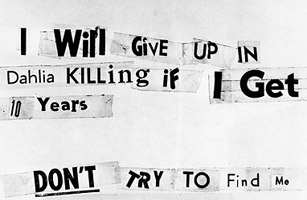
Set in the post-war Los Angeles boom, the unsolved murder of Elizabeth Short is a cautionary tale about big cities, America's peripatetic population and the dangers of the new vast urban landscapes of the nation. On Jan. 15, 1947, a severely mutilated, naked body, sliced in half at the waist and a grotesque grimace carved into her face, was found not far from Hollywood. The corpse was that of 22-year-old Short, who had moved to California to from the East Coast to pursue an acting career but ended up serving tables. Reporters gave her the nickname "Black Dahlia," perhaps inspired by the recently released Blue Dahlia, a film in the Hollywood noir style about a fighter bomber accused of the death of his faithless wife. (Short had been engaged to a major in U.S. Air Force but he died in a plane crash in August 1945.) The case generated a huge list of potential suspects and possible motives, as well as urban legends about the victim's sexual and moral proclivities. With its morbid air of noir nostalgia, the Black Dahlia has also inspired a large number of novels and movies over the years.
From the Archive:
Review: The Black Dahlia